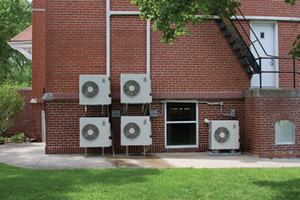Zoned Technology Leads to Lower Electric Bills

With Zoned Comfort Solutions from Mitsubishi Electric, St. Joseph’s no longer fears high electrical bills and is able to offer students and teachers a comfortable learning environment year-round.
After many years running on an outdated boiler system and noisy AC units, St. Joseph School, in Pilot Grove, Mo., needed to find an HVAC system that could efficiently cool and heat the 5,400-square-foot building without disrupting day-to-day activities. The solution: Zoned Comfort Solutions from Mitsubishi Electric Cooling & Heating.
With these needs in mind, the school worked with Jamie Callahan of Air and Water Solutions. Callahan believed there was only one solution for St. Joseph’s—zoned technology, and he recommended Zoned Comfort Solutions from Mitsubishi Electric as the brand for the school to install. He said, “The school didn’t want to reuse the gas boiler, and with the energy efficiency of Mitsubishi Electric units, it was the only option.”
The installation took only two weeks and Callahan has received nothing but positive feedback from the school, specifically with the system’s ability to offer cost savings. He said, “From what I’ve heard, the school went from paying thousand dollar electric bills to paying $245 a month. That’s nearly 25 percent of the original cost.”
The staff agrees that the experience has been great. Principal Nichole Watring said, “We have not had any issues with the system and the teachers and students love that they can control the temperature of their rooms. It’s much quieter and more efficient than the previous system.”
The school was also pleased with the system’s appearance. School Manager Donna Gerke said, “We looked for a system that offered more cost savings and efficiency but aesthetics was an added bonus. It’s given the school a whole new look on the inside. It looks fresher and cleaner.”
With Zoned Comfort Solutions from Mitsubishi Electric, St. Joseph’s no longer fears high electrical bills and is able to offer students and teachers a comfortable learning environment year-round.
www.mitsubishicomfort.com
This article originally appeared in the School Planning & Management June 2018 issue of Spaces4Learning.